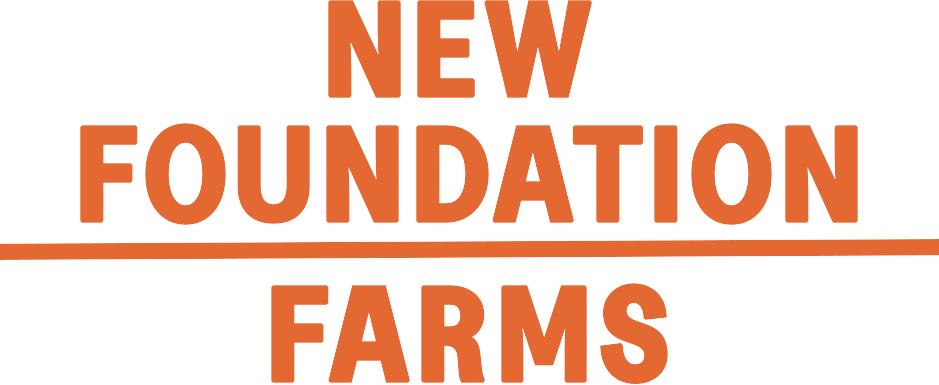
THE KNOW-HOW
NEW FOUNDATION FARMS IS A RADICAL NATURAL DISRUPTOR ENTERPRISE.
WE CALL OUR APPROACH DEEP REGENERATION. BEFORE WE GROW FOOD, WE ARE STEWARDS OF ABUNDANT ECOSYSTEMS.
WE BELIEVE THAT REGENERATION IS COLLABORATION, AND WE OPERATE WITH AN OPEN-SOURCE ATTITUDE.
This section contains animations showing the methodology we use to achieve deep regeneration as we transform traditional farmland into an organic stacked enterprise system using methods such as biodynamic and permaculture systems.
INSIGHT #01:
STEWARDING LAYERED ECOSYSTEMS
INSIGHT #02:
HARVESTING SUNLIGHT FROM THE TOP OF THE TREES DOWN INTO THE SOIL
INSIGHT #03:
HOW DEEP REGENERATION WORKS IN THE FIELD
INSIGHT #06:
TURNING ECONOMICALLY MARGINAL FARMS INTO PROFITABLE HUBS OF RURAL REGENERATION
The New Foundation Farms’ agricultural model is a far departure from the conventional food production in the UK. We have designed an animation to showcase how our innovative stacked enterprise gives rise to a sophisticated ecosystem both above and below the surface. In this unique system, the soil biology nourishes the above-ground growth, and reciprocally, the vegetation enhances the soil biology.
One of the most visually striking contrasts lies in the variation in height. By incorporating native and fruiting trees, we have created vertical layers that effectively reduce the amount of sunlight reaching the bare ground. This approach captures significantly more carbon compared to other agricultural methods.
As a result, our farms’ appearance will be unlike any traditional farm you have ever witnessed. It stands as a testament to our commitment to sustainability and ecologically conscious practices, fostering a harmonious coexistence between agriculture and the environment.
Our second animation demonstrates how our model efficiently captures sunlight, harnessing our greatest asset to its fullest potential.
Sunlight and rainwater alone hold the key to food production, yet the conventional farming approach fails to recognise the immense potential for carbon capture. When sunlight reaches bare earth, it squanders the opportunity for photosynthesis to harness that energy and remove carbon dioxide from the atmosphere. Moreover, this sunlight-induced heat warms the ground, leading to its radiation back into the atmosphere, contributing to global warming. This farming method remains confined to a two-dimensional flat plain, displaying a limited and reductionist approach.
In stark contrast, New Foundation Farms has devised a model that minimises the exposure of bare ground to sunlight. Through the implementation of multi-layered planting across a vast vertical range, sunlight capture is maximised in three dimensions. Thoughtfully selected plant combinations work in harmony throughout the growing season, ensuring prolonged and efficient solar energy capture.
This forward-thinking approach is aptly named three-dimensional farming, and given its progressive development over time, it could very well be referred to as four-dimensional farming. By embracing this innovative strategy, we have the opportunity to revolutionise agriculture while promoting sustainable practices and mitigating climate change.
INSIGHT #04:
COWHOW, OUR REGENERATIVE SYSTEMS MODELLING SOFTWARE
Our third and final animation in the series presents a two-dimensional plan illustrating how our model operates. In this instance, we have taken a typical 250-acre plot of conventionally farmed arable land and envisioned how the New Foundation Farms model can be applied.
The above three-dimensional cross-section of our agroecological farming model provides an additional layer of literal context to this visual depiction.
As you observe this animated infographic, it’s essential to recognise that each sequence represents a customised approach tailored to a specific plot of land. Each land parcel possesses its own unique microclimate, hydrology, nutrient deficiencies, aspect, exposure, topography, altitude, and numerous other variables, even in seemingly small areas. All these factors are meticulously taken into account as we work towards restoring and rebalancing the ecosystem.
Our model is intricately designed to adapt and harmonise with the natural intricacies of each piece of land we work with.
What this animation does above all else is that it demonstrates the sharp contrast with industrialising agriculture which reduces the complexity of ecosystems and extracts from them, rather than builds them.
We call our custom-built software ‘Cow How,’ and it serves as a powerful tool that drives our business operations. To showcase its capabilities and functionality, we’ve produced a series of short films.
At its core, ‘Cow How’ is a sophisticated calculation tool that harnesses real-world data and numerous variables. By incorporating inputs related to enterprises and regeneration from both financial and bio-asset perspectives, it empowers us to make informed decisions.
One of the key features of ‘Cow How’ is its application of the ‘bare earth’ approach across various sites. It seamlessly integrates different site models into a master model, which is then connected with the financial aspects of our central enterprise overheads. This comprehensive integration completes the modelling process, enabling ‘Cow How’ to effectively simulate integrated financial and farming operations. As a result, it can translate regenerative farming practices into insightful financial analyses, tailored to the specific requirements of each farm.
Furthermore, ‘Cow How’ establishes a vital link with our earlier field-to-fork modelling, leveraging real market data. This connectivity creates a holistic regenerative field-to-fork model, allowing us to gain deeper insights and make well-informed decisions based on accurate data and real-world dynamics.
INSIGHT #05:
TURNING ECONOMICALLY MARGINAL FARMS INTO PROFITABLE HUBS OF RURAL REGENERATION
This second animation provides a glimpse into the astonishing intricacy of CowHow. Countless variables contribute to the creation of our exclusive software, making it genuinely unparalleled. Every data point is derived from real-world examples, setting it apart from anything else available. CowHow not only offers methods for regenerating landscapes but also integrates enterprises on the farm to optimize yields and income while minimizing expenses and inputs.
One distinguishing feature is the integration of dynamic financial modelling. This system evolves over time, monitoring the balance of payment assets and their capacity to generate surplus products without compromising the overall system’s integrity
Here is a third animation that illustrates the remarkable scalability of our regenerative model in cultivating new enterprises within the farming business.
The animation demonstrates how, as the land under management expands, the economies of scale drive greater efficiency and profitability across the entire operation.
This showcases the significant potential our regenerative approach holds for fostering growth and regeneration of not just ecosystems but also of people, of local economies, and of public health.
THOUGHT LEADERSHIP: OVERVIEW OF THE THINKING AND PRINCIPLES BEHIND REGENERATIVE APPROACHES IN AGRICULTURE AND LAND MANAGEMENT
Our Collaborative CEO Marcus Link co-authored the extensive research report Farming Smarter: The Case for Agroecological Enterprise.
A 86-page report co-authored by Marcus Link and Tony Greenham was published by the Food, Farming & Countryside Commission in November 2020.
Farming Smarter: the case for agroecological enterprise sets out the business case for agroecology at a farm level and the policy-level vision required to allow farm businesses to transition to this model with confidence.
Link and Greenham consider how farmers can transition to smarter approaches at pace and scale, analyse what hinders change from being adopted more quickly, and map out the landscape and frameworks for assessing the effectiveness of agroecological approaches.
Farming Smarter is intended as an overview of the thinking and principles behind agroecological approaches to agriculture and land management. It explores the economic argument for regenerative farming and confirms that there is no need for a trade-off between profit and nature in an agroecological system.
The report reinforces the view that many farmers are ready for change but need clarity of vision from policy makers for a joined-up food and farming system that will allow them to transition with confidence. The business case for agroecology at a farm level is fast emerging.
Current business models are fragile and questions are growing about the climate resilience of intensive agriculture in the face of evidence of extreme weather events (NFU Harvest Survey data for 2020 reports the smallest harvest since 1981 and yields down 15-18% across key crops). Unsurprisingly given these factors, farmers are changing their mindsets and re-ordering farming systems – but they need policy changes that help them to succeed. Farming Smarter navigates this territory and provides a useful summary of the economic case for agroecology.
The report identifies three specific actions in the UK that would help it grasp the potential of agroecology:
1. Research and knowledge dissemination
There is an urgent need for relevant research; in particular, more robust methods are needed to measure and quantify ecologically meaningful outcomes, and further research is needed into the most efficient approaches and combinations of approaches in different ecoregions of the UK.
2. Investing in agroecology at pace and scale
There is a shortage of appropriate finance for some viable business propositions. Even where external finance is available, or transition to agroecology can be financed from internal business cash flows, to achieve change at necessary
pace and scale requires a significant mobilisation of a range of forms of capital including equity and debt.
3. Supporting the agroecological entrepreneur
The nature of agroecology is knowledge intensive and requires an appetite for innovation and risk that would be greater enhanced by robust business support including training, mentoring and effective diffusion of knowledge. The challenge posed by the large cohort of farmers at retirement age should be grasped as an opportunity to back a new generation of agroecological farmers.


